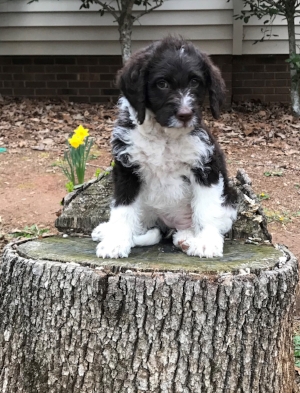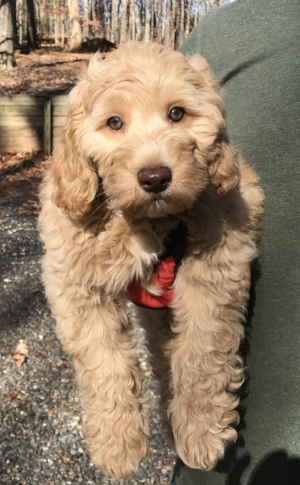What is a Labradoodle?
F1 Labradoodle, F1B, Multigen, Authentic Multi-generational Australian, what's it all about?
When someone has made the decision to bring a Labradoodle into their home they are immediately confronted with a problem. What are the different designations of a Labradoodle referring to? F1, F1B, Multigen, what is it all about? You thought this was going to be simple, only to find that there is a great variation of Labradoodle designations, coats and price. When this is discovered you have questions and I hope that to some degree I can help you with those questions here.
What exactly is a Labradoodle anyways?
The Labradoodle was first created in Australia when a request came to the Royal Guide Dogs from a lady who was blind that needed a guide dog that would not affect her husbands allergies.From this request, a Labrador Retriever was crossed with a Standard Poodle and the result was the Labradoodle. This is where it all began.
1. To produce a Labradoodle you must cross a Labrador Retriever with a Poodle. Hence, a Labradoodle! The first time you cross a Lab to a Poodle the designation of this crossing is a F1 Labradoodle. The genetic make up of this crossing is 50% Poodle and 50% Retriever. From this breeding you can get a wide variety of coats, shedding and hypoallergenic traits. This first crossing can produce pups that favor very much the looks of a lab, or favor more the looks of a Poodle. They may or may not be somewhat hypoallergenic. They will most likely have reduced shedding but will still experience some hair loss. Although one of my dogs (Greta) obviously got the majority of the Poodle gene, most of the time the coat on these dogs will be more coarse and wiry than some of the fluffy Labradoodles that you see in pictures. These are great dogs. And the trade off of the wiry coat is very low maintenance.
2. When you breed a F1 Labradoodle back to a Poodle it becomes a F1B Labradoodle. The B stands for " Back Bred". This crossing result is a pup that is 75% Poodle and 25% Lab and can produce some very beautiful pups. You have the potential in every litter that one or two of the pups will not quite pull from the gene pool what is necessary for a pup to to get a coat that is soft and curly and will still favor more the looks of a F1, so the inconsistency of coat is still there to a small degree. But most of the pups in this litter should have a soft coat that can range from wavy to tighter curls. I have gotten the full range in my litters.
When you breed a F1B Labradoodle to another F1B Labradoodle or a Poodle, this pup becomes a third generation or a multi generational Labradoodle. This crossing results in a pup that is genetically about 85% Poodle and 15% Lab. This generation of Labradoodle should be more consistent in coat, hair loss should be at a minimum and non aggravating to people who typically experience allergies to dogs.These are also some very beautiful pups and are the result of some hard work, selective breeding, patience and time.
4. To be an Australian Labradoodle, a pup must have the DNA of a Poodle, Labrador and Cocker Spaniel. These pups will have a beautiful fleece or wool coat that can be straight or wavy or have long spiraling curls, depending on the breeding. These dogs should not aggravate people who have dog allergies and hair loss should be at an absolute minimum. These pups should be great as therapy dogs as long as the breeder has taken care and been selective in the pairings for breeding.
5. A Authentic Multigenerational Australian Labradoodle comes about as the result of breeding one Australian Labradoodle to another for at least 6 generations .
6. The Merriam-Webster dictionary defines "purebred" as " bred from members of a recognized breed, strain, or kind without admixture of other blood over many generations". The AKC requires four generations of like-to-like mating in their foundation service. At this point, when Australian Labradoodle has bred to Australian Labradoodle for four or more generations, these pups become designated as Purebred Multigenerational Australian Labradoodles. There has been no infusion of any of the parent breeds for at least three prior generations. These pups are the result of many years of hard work and selective breeding. They are beautiful dogs that should be hypoallergenic, non shedding and have a coat that feels soft to the touch. They can be straight, curly or wavy depending on the coat of the dogs that they were paired with.
How much do your puppies cost?
Prices can vary so please contact for pricing information. We’ve also got an ADOPTION APPLICATION page available if you’re ready to get started!
I have other questions—how do I reach you?
There are lots of ways to connect with us! You can fill out an online form HERE, or directly EMAIL us or even call us at: 336-543-7408.
Amanda is a F1B Labradoodle. Her coat was a little more thin and wiry, resembeling more the coat of a lab than a Poodle
Figgy is also a F1B Labradoodle and has a soft and curly coat
Jax is a Multigenerational Australian Labradoodles with a fleece coat.
Izzy is a multigenerational Australian Labradoodle with a wool coat.
This pup is also a F1 Labradoodle. You can see how straight the hair is. A F1 is 50% lab and 50% Poodle. These pups generally have a coat that is straighter and more wiry..... but require less maintenance.





